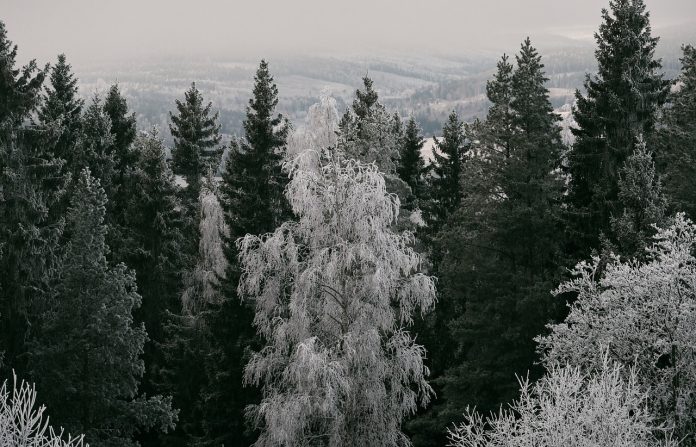by Tom Gilbert, Co-Executive Director, New Jersey Conservation Foundation
‘Tis the season to deck the halls with boughs of holly, decorate evergreen trees with twinkling lights, make wreaths from sprigs of greenery, and hang mistletoe from the ceiling. These pops of green have a magical way of making a home feel cozy and festive during the shortest days of winter!
Did you ever wonder why some trees and shrubs stay green all year round, while other trees shed their leaves before winter?
Science holds the answer to this burning (or freezing) question!
According to Dr. Emile DeVito, New Jersey Conservation Foundation’s staff biologist, deciduous trees don’t lose their leaves because they’re trying to avoid the cold, or because they don’t get enough sunlight. What they’re doing is preparing themselves for winter drought conditions.
You’re probably thinking: Drought? What drought? New Jersey gets plenty of rain, and occasionally some snow.
But even during wet and snowy winters in this state we’re in, water becomes nearly unavailable to tree roots once the soil becomes cold enough to freeze. When the ground is frozen solid, it might as well be the Sahara as far as drought-intolerant species like sugar maples are concerned.
Over millennia, deciduous trees adapted to protect themselves from impending drought. After putting on a spectacular autumn burst of color, our deciduous oaks, maples and birches shed their leaves.
The best evidence of leaf loss as preparation for drought, DeVito says, can be found in tropical forests with extended dry seasons, like those in southern Mexico or the lowlands of Bolivia. When the rainy season ends in these places, soil moisture drops to near zero. Because broad leaves on trees typically evaporate lots of water into the atmosphere, even tropical deciduous trees will shed their leaves to prevent tissue death due to drying out.
Evergreens, on the other hand, are very efficient at conserving moisture. Evergreen leaves are tough and waxy, allowing these trees and shrubs to lose far less water.
Evergreen needles are essentially rolled leaves – hollow tubes with all their evaporative pores tucked away on their inner walls. “Like penne pasta drained in a sieve, needles resist evaporation by trapping moisture inside,” explains DeVito.
Not all evergreens have needles. Hollies and rhododendrons are among the New Jersey native plants with broad leaves that are able to stay green and leafy all winter.
Rhododendrons can roll their leathery leaves into tubes to resist freeze-drying in the cold and wind! When you see a rhododendron with rolled leaves on a sub-freezing winter day, you may think it has died. No, it has just turned its leaves into giant evergreen needles! Holly leaves also curl during exceptionally cold weather.
Deciduous forests aren’t found everywhere. If you were to see a visualization of what North America looked like from space on a winter day hundreds of years ago – before European colonization and all the resulting development – you’d see most of New Jersey as part of a wide, leafless, brown “waistband” of deciduous forests. (Our state’s Pine Barrens region would be an exception, of course!)
To the north of this brown waistband, you’d see lots of green: vast evergreen forests of spruce and fir stretching from northern Canada to the giant hemlock/white pine forests of the Great Lakes and northern New England. To the south, green would resume: the pine and live oak forests of the Deep South, with evergreens continuing as the dominant forest types all the way into the tropics.
In the far north you’d also see white, where the snow cover is deep and insulating. Snow comes early in the north, before the entire root zone of the soil has frozen. This snow cover gives trees an amazing amount of protection.
But a short distance to the south, where prolonged snow cover is uncommon, the roots of deciduous oaks, maples and birches can freeze solid. As DeVito notes, a tree or shrub is more likely to have frozen roots and experience “winter burn” at Morven in Princeton than in Tillman’s Ravine Natural Area in northern New Jersey!
Falling leaves are an “evolutionary bet” that a thick layer of snow will not be available to protect roots from a deep freeze.
As climate change impacts the predictability of snow cover in northern New Jersey and southern New England, DeVito predicts that deciduous species could gain an edge over evergreens and expand their range northward.
But as the climate fluctuates, he adds, alien species could invade the competitive cracks that open up in native species habitats. Natural plant communities are tuned in to long-term climate patterns over the last few thousand years, and rapid changes could easily allow aggressive takeovers by alien species and a loss of native forest diversity.
This holiday season, enjoy our evergreens and the beauty they bring to both outdoor and indoor settings. And let them be a reminder of the many other benefits that trees provide including clean air, clean water, shade from the heat, flood control, carbon storage and habitat for diverse species of wildlife!
For information on preserving New Jersey’s land and natural resources, visit the New Jersey Conservation Foundation website at www.njconservation.org or contact me at [email protected].


